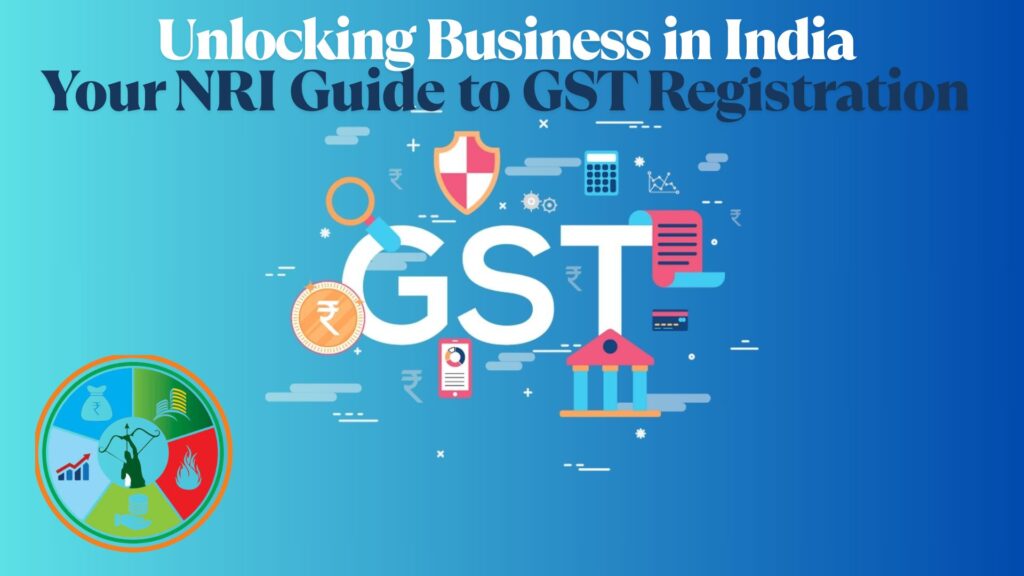India’s Goods and Services Tax (GST) is a landmark tax reform, creating a unified indirect tax system across the nation. For Non-Resident Indians (NRIs) aiming to tap into the vibrant Indian market, understanding and complying with GST is not just a regulatory requirement, but a foundational step towards seamless business operations. Whether you are planning to supply goods, offer services, or engage in e-commerce, GST registration often becomes a necessity for NRIs conducting business in India.
This comprehensive guide is crafted to simplify the GST registration process for NRIs. We will walk you through each step, outlining prerequisites, the online registration procedure, and essential points to remember, ensuring you can navigate this crucial aspect of doing business in India with confidence and ease.
Who Needs GST Registration as an NRI? Understanding Mandatory Requirements
Determining if GST registration is mandatory for your NRI business venture is the first crucial step. Indian GST law has specific provisions for “Non-Resident Taxable Persons,” and the criteria for registration are often different from resident businesses.
- Engaging in Taxable Supply: If you, as an NRI, are involved in any “taxable supply” of goods or services within India, GST registration is mandatory. This applies regardless of your turnover or the scale of your operations. Even a single taxable transaction triggers the registration requirement for NRIs.
- No Threshold Exemption for NRIs: Unlike resident businesses that may have turnover thresholds below which GST registration is not compulsory, this threshold exemption does not apply to NRIs. This means even if your business turnover is minimal, if you are making taxable supplies, you must register for GST.
- Examples of Taxable Supply: Taxable supply encompasses a wide range of business activities, including:
- Selling goods or products to customers in India.
- Providing services to clients or businesses located in India.
- Importing goods into India and supplying them domestically.
- Operating e-commerce platforms targeting Indian consumers.
- Participating in exhibitions or trade fairs in India and making sales.
If your intended business activities fall under any of these categories or involve taxable supplies within India, GST registration is a non-negotiable legal requirement.
Prerequisites for GST Registration: Getting Your Documents Ready
Before you begin the online GST registration process, gathering the necessary documents and information is essential. Having these prerequisites in order will ensure aスムーズ and efficient application process.
1. Valid Passport: Your Primary Identification Document
- Scanned Copy with Visa: You will need a scanned copy of your valid passport. Crucially, ensure the passport copy includes your valid Indian Visa. The visa confirms your legal authorization to be in India, even for business purposes.
2. Tax Identification Number (TIN) – If Applicable in Your Country of Residence
- Unique Identification from Your Home Country: If your country of residence issues a Tax Identification Number (TIN) or any other unique identification number for tax purposes, you will need to provide this. This helps establish your tax identity in your home country and is part of the KYC (Know Your Customer) process.
3. Indian Business Address Proof: Establishing Your Place of Business in India
- Proof of Address for Business Location: You must provide proof of address for your primary business location in India. This could be:
- Rental Agreement: If you are renting a business space.
- Utility Bill: A utility bill (electricity, water, gas) in the name of the property owner (if renting) or in your name (if owning). Ensure the bill is recent (not older than 2-3 months).
- Property Tax Receipt: If you own the business premises in India.
- NOC (No Objection Certificate): If using a co-working space or a shared office, you may need an NOC from the owner/operator along with their address proof.
The address proof must clearly state the complete address of your business location in India.
4. Authorized Representative Details: Your Point of Contact in India
- Details of an Indian Authorized Representative: As an NRI, you must appoint an “Authorized Representative” who is a resident of India. This person will act as your primary point of contact for all GST-related matters and will be responsible for compliance on your behalf.
- PAN (Permanent Account Number): Your authorized representative must have a valid PAN card.
- Aadhaar Number: While Aadhaar may not be mandatory for the NRI applicant, it’s generally required for the authorized representative for authentication and KYC purposes.
- Letter of Authorization: You will need to provide a letter of authorization formally appointing this representative.
- Contact Details: Full name, address, email ID, and mobile number of the authorized representative.
Choosing a reliable and GST-knowledgeable authorized representative is crucial for compliance and smooth communication with GST authorities.
5. Indian Bank Account Details: For Tax Payments and Refunds
- Bank Statement or Canceled Cheque: You need to provide details of a bank account held in India in your business name or your name.
- Bank Statement: A recent bank statement (not older than 2-3 months) clearly showing your account number, IFSC code, bank name, and address.
- Canceled Cheque: Alternatively, a canceled cheque from your Indian bank account, with your name (or business name) and account details pre-printed.
Having an Indian bank account is essential for making GST payments, receiving any potential GST refunds, and for general business financial transactions in India.
Step-by-Step Guide: NRI GST Registration – Your Online Process
With your prerequisites in hand, follow these steps to complete your GST registration online:
Step 1: Visit the Official GST Portal – Your Gateway to Registration
- Access the GST Portal: Open your web browser and navigate to the official Goods and Services Tax portal: www.gst.gov.in . This is the central online platform for all GST-related activities in India.
- Navigate to “New Registration”: On the GST portal homepage, locate the “Services” tab in the main menu. Hover over “Services” and click on “Registration,” then select “New Registration” from the dropdown menu. This will take you to the GST registration application page.
Step 2: Fill in Part A of the GST Registration Form – Basic Details
- Select “Taxpayer Type”: On the registration application page, you will be asked to select your “Taxpayer Type.” From the dropdown options, choose “Non-Resident Taxable Person.” This correctly identifies your category as an NRI applicant.
- Provide Basic Details: Enter the required basic details in Part A of the form. This typically includes:
- Legal Name: Enter your legal name as it appears in your passport.
- Permanent Account Number (PAN): As an NRI, you may not have an Indian PAN immediately. In some cases, you might be able to proceed without it initially, but obtaining a PAN is generally recommended for long-term business operations and may be required at later stages. Check the GST portal for the latest requirements regarding PAN for NRIs.
- State and District: Select the Indian state and district where your business is located from the dropdown menus.
- Email Address: Provide a valid and active email address. Ensure it is one you can regularly access as all GST-related communications, including OTPs and your GSTIN, will be sent to this email.
- Mobile Number: Enter a valid mobile number. Preferably, provide an Indian mobile number if you have one. If not, you may be able to use an international mobile number, but ensure it is active to receive OTPs.
- Verify via OTP: After entering these details, you will need to verify your email address and mobile number through One-Time Passwords (OTPs). Click on “Proceed.” Separate OTPs will be sent to your provided email and mobile number. Enter these OTPs in the designated fields and click “Verify OTP.”
- Temporary Reference Number (TRN): Upon successful OTP verification, the GST portal will generate a Temporary Reference Number (TRN). This TRN is crucial. Note down or save this TRN as it will be used to access and complete Part B of the registration application.
Step 3: Fill and Submit Part B of the GST Registration Form – Detailed Information and Document Uploads
- Access Part B using TRN: Return to the GST portal homepage, go to “Services” > “Registration” > “New Registration.” This time, select “Temporary Reference Number (TRN)” option. Enter the TRN you received in Step 2 and the captcha code, then click “Proceed.”
- OTP Verification Again: You will again be prompted to verify your mobile number or email address using an OTP. Complete this verification process to proceed to Part B of the form.
- Fill in Detailed Information: Part B of the GST registration form requires you to fill in detailed information across various sections. These sections typically include:
- Business Details: Provide comprehensive details about your business, including the legal name, trade name (if any), principal place of business address (as per your address proof), nature of business activities, and main commodities or services you will be dealing with.
- Promoter/Partners Details: Since you are an NRI and likely a sole proprietor or representing a foreign entity, you will need to provide your details as the promoter. This will involve information from your passport and details of your authorized representative.
- Authorized Signatory Details: Provide details of your authorized representative in India, including their PAN, Aadhaar (if applicable), address, and contact information. Upload the Letter of Authorization.
- Principal Place of Business: Re-enter your principal place of business address in India.
- Details of Goods and Services: Specify the main goods and services that your business will supply. Use the Harmonized System of Nomenclature (HSN) codes for goods and Services Accounting Codes (SAC) for services, if applicable (you can search for these codes on the GST portal).
- Bank Account Details: Enter your Indian bank account details, as per the bank statement or canceled cheque you have.
- Upload Required Documents: In the relevant sections of Part B, you will need to upload scanned copies of all the prerequisite documents you prepared, including:
- Passport copy (with visa)
- Tax Identification Number (TIN) proof from your country of residence (if applicable)
- Proof of Indian Business Address
- Photograph of the authorized representative
- Letter of Authorization for the representative
- Bank statement or canceled cheque
Ensure all documents are clear, legible, and uploaded in the prescribed file size and format (usually JPEG or PDF, with size limits specified on the portal).
Step 4: Make the Advance Tax Deposit – Security for GST Compliance
- Advance Tax Payment for NRIs: As a Non-Resident Taxable Person, you are generally required to make an advance deposit of GST. This is essentially an advance payment of your estimated tax liability for the period you intend to operate in India (typically for the registration validity period).
- Estimate Tax Liability: You will need to estimate your anticipated GST liability for the registration period (initially up to 90 days, extendable). This estimate should be a reasonable projection of your taxable supplies and applicable GST rates.
- Online Payment: The GST portal provides options for online payment of this advance deposit. You can use net banking, credit cards, or debit cards for payment. Follow the online payment instructions provided on the portal after submitting Part B.
Step 5: Submit the Application – Finalizing Your Registration
- Submit Part B: After filling in all sections of Part B, uploading documents, and making the advance tax deposit, review all the information carefully for accuracy.
- Digital Signature or E-Verification: You will need to digitally sign your GST registration application. This can be done using:
- Digital Signature Certificate (DSC): If you have a DSC, you can use it to digitally sign the application.
- E-Verification using OTP: Alternatively, you can use e-Verification through OTP sent to the mobile number linked to your Aadhaar of the authorized representative (if Aadhaar based e-KYC is enabled and applicable). Check the GST portal for current e-verification options available for Non-Resident Taxable Persons and their representatives.
- Application Reference Number (ARN): Upon successful submission, you will receive an Application Reference Number (ARN). This ARN is critically important. Note down or save your ARN. It is your unique reference number for tracking the status of your GST registration application.
Step 6: Receive Your GST Identification Number (GSTIN) – Successful Registration
- Application Verification: After submission, the GST authorities will verify your application and the submitted documents. This verification process may take some time.
- Track Application Status: You can track the status of your GST registration application online using your ARN on the GST portal under “Services” > “Registration” > “Track Application Status.”
- GSTIN Issuance via Email: If your application is approved after verification, you will receive your GST Identification Number (GSTIN). The GSTIN is a 15-digit alphanumeric number that uniquely identifies you as a registered taxpayer under GST. The GSTIN certificate is typically sent to your registered email address and may also be available for download on the GST portal.
- Commence Business Operations: Once you receive your GSTIN, you are officially registered under GST and can commence your business operations in India, ensuring all your invoices and tax compliances are in line with GST regulations.
Key Points to Remember for NRI GST Registration and Compliance
Keep these crucial points in mind for ongoing GST compliance:
- Validity Period: Limited to 90 Days (Initially Extendable)
- GST registration for Non-Resident Taxable Persons is initially granted for a maximum period of 90 days from the date of registration OR the period specified in your application, whichever is earlier.
- Extension Possible: You can apply for an extension of this validity period if needed. You must apply for extension before the expiry of the initial registration period. The extending authority may grant extensions for further periods up to 90 days at a time, subject to conditions.
- GST Returns Filing: Periodic Compliance is Mandatory
- File GSTR-5: As a Non-Resident Taxable Person, you are required to file a specific GST return known as GSTR-5. This return needs to be filed monthly, regardless of whether you had any business activity in a particular month. Even “Nil” returns must be filed if there were no transactions.
- Due Dates: GSTR-5 is typically due on or before the 20th of the month following the tax period (month). Adhere strictly to these due dates to avoid penalties.
- Accurate Record Keeping: Maintain meticulous records of all your sales, purchases, input tax credit claimed, and other relevant financial transactions to accurately file your GST returns.
- Consequences of Non-Compliance: Penalties and Legal Repercussions
- Late Filing Penalties: Failure to file GST returns (GSTR-5) by the due dates will attract late fees and penalties, which can accumulate over time.
- Interest on Delayed Tax Payment: If you delay payment of your GST liability, you will be charged interest on the outstanding tax amount.
- Cancellation of Registration: Consistent non-compliance or serious violations of GST regulations can lead to cancellation of your GST registration. This will halt your legal ability to conduct taxable business in India and may have further legal repercussions.
- Legal Action: In cases of tax evasion or fraudulent activities, GST authorities can initiate legal action, which may include fines, penalties, and even prosecution.
- Advance Tax Deposit Adjustment:
- The advance tax deposit you made during registration is meant to be adjusted against your actual GST liability during your registration period.
- At the end of your registration validity period, you will need to reconcile your actual tax liability with the advance deposit. Any excess deposit may be eligible for refund as per GST rules, and any shortfall must be paid.
Seeking Professional Assistance and Support
While this guide provides a comprehensive overview, GST regulations can be complex and subject to updates. For NRIs, especially when starting a business in a new country
- Consult a Tax Professional: It is highly recommended to consult with a qualified tax consultant or chartered accountant (CA) in India who specializes in GST and NRI taxation. They can provide personalized guidance, assist with the registration process, ensure accurate return filing, and help you navigate any complex GST-related issues.
- Contact the GST Helpline: The GST department provides helplines and customer support services. You can contact the GST helpline for general queries or technical assistance related to the GST portal and registration process. Visit the GST portal (www.gst.gov.in ) for contact details.
Conclusion: Your GST Registration – Paving the Way for Business Success in India
GST registration is a foundational step for NRIs establishing a business presence in India. By meticulously following this step-by-step guide, preparing the necessary documents, and understanding the key compliance requirements, you can navigate the GST registration process efficiently and effectively. Staying GST compliant is not just about adhering to legal obligations; it’s about building credibility, fostering trust with Indian business partners and customers, and laying a solid foundation for your business to thrive in the dynamic Indian market. Embrace GST compliance as an integral part of your Indian business strategy and pave the way for long-term success.



